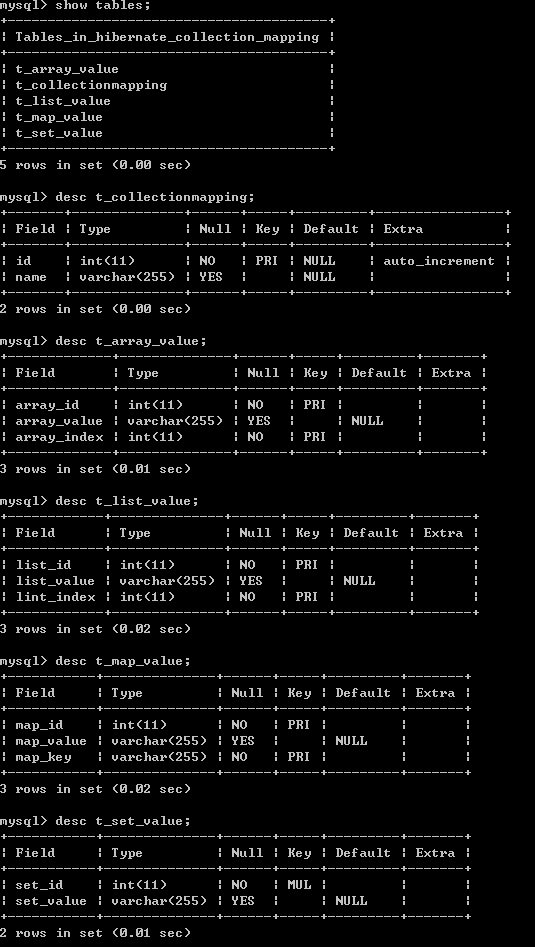其它映射包括如下:
- Set:<set>标签映射
n 并非一对多,多对一关联映射,此处的set中为普通数据类型,不是对象(如果是对象则是一对多,多对一)
n Hibernate会使用一个单表来存储set元素,并加入一个外键参照主表记录,无序
- List:<list>标签映射
n Hibernate会使用一个单表来存储list元素,并加入一个外键参照主表记录,
n 因为list是有序的,所以hibernate需要加入一个索引字段,以保持存储顺序
- Array:<array>标签映射
n Hibernate会使用一个单表来存储array(数组)元素,并加入一个外键参照主表记录,
n 因为array(数组)也是有序的,所以hibernate也需要加入一个索引字段,以保持存储顺序
- Map:<map>标签映射
n Hibernate会使用一个单表来存储array(数组)元素,并加入一个外键参照主表记录,
n 因为map中有key和value,所以这两个字段是必需的。加上一个外键,共三个字段
n 因为Map是无序的,所以不用考虑顺序
实例类
如下:
public class CollectionMapping { private int id; private String name; private Set setValue; private List listVale; private String[] arrayValue; private Map mapValue; public int getId() { return id; } public void setId(int id) { this.id = id; } public String getName() { return name; } public void setName(String name) { this.name = name; } public Set getSetValue() { return setValue; } public void setSetValue(Set setValue) { this.setValue = setValue; } public List getListVale() { return listVale; } public void setListVale(List listVale) { this.listVale = listVale; } public String[] getArrayValue() { return arrayValue; } public void setArrayValue(String[] arrayValue) { this.arrayValue = arrayValue; } public Map getMapValue() { return mapValue; } public void setMapValue(Map mapValue) { this.mapValue = mapValue; } }
Hibernate对集合的存储关系:
t_collectionMapping
|
Id |
Name |
|
1 |
Xxxx |
对于set的存储(无序)
|
Set_id(是一个外键参照上面的主表id) |
Set_value |
|
1 |
A |
|
1 |
B |
对于list的存在(有序:存入时需要存入一个索引以保持顺序)
|
List_id(是一个外键参照上面的主表id) |
List_value |
List_index(用于保持顺序) |
|
1 |
C |
0 |
|
1 |
D |
1 |
对于array(数组)的存在(有序:存入时需要存入一个索引以保持顺序)
|
array_id(是一个外键参照上面的主表id) |
array_value |
array_index(用于保持顺序) |
|
1 |
E |
0 |
|
1 |
F |
1 |
对于Map的存储(无序)
|
Map_id(是一个外键参照上面的主表id) |
Map_key(Map中的Key) |
Map_value(Map中的value) |
|
1 |
K1 |
V1 |
|
1 |
K2 |
V2 |
集合关联映射文件实例:
<hibernate-mapping>
<class name="com.wjt276.hibernate.CollectionMapping" table="t_collectionMapping">
<id name="id" column="id">
<generator class="native"/>
</id>
<property name="name" column="name"/>
--------set--------------------------------------------------------------------------
<!-- 使用<set>标签来映射Set类型,Set类型会映射到数据库中成为一个表
name属性:对象属性名称
table属性:重新指定表名
再使用<key>标签在表映射一个外键参照<class>标签映射的表的主键
-->
<set name="setValue" table="t_set_value">
<key column="set_id"/>
<!-- 使用<element>标签来映射一个字段,用于存储Set中的元素,元素是普通类型
type属性:指定Set存储元素的hiberante数据类型,也可以是Java包装类
column属性:指定字段名
如果元素是对象则使用<composite-element>标签映射
class属性:指定对象的完整包名
column属性:指定字段名
-->
<element type="string" column="set_value"/>
</set>
--------List--------------------------------------------------------------------------
<!-- 使用<list>标签来映射list类型,list类型会映射到数据库中成为一个表
name属性:对象属性名称
table属性:重新指定表名
再使用<key>标签在表映射一个外键参照<class>标签映射的表的主键
因为list是有序的,所以需要使用<list-index>标签加入一个索引字段,以保持存储顺序
-->
<list name="listValue" table="t_list_value">
<key column="list_id"/>
<list-index column="lint_index"/>
<!-- 使用<element>标签来映射一个字段,用于存储list中的元素,元素是普通类型
type属性:指定list存储元素的hiberante数据类型,也可以是Java包装类
column属性:指定字段名
如果元素是对象则使用<composite-element>标签映射
class属性:指定对象的完整包名
column属性:指定字段名
-->
<element type="string" column="list_value"/>
</list>
--------Array-------------------------------------------------------------------
<!-- 使用<array>标签来映射array(数组)类型,array(数组)类型会映射到数据库中成为一个表
name属性:对象属性名称
table属性:重新指定表名
再使用<key>标签在表映射一个外键参照<class>标签映射的表的主键
因为array(数组)是有序的,所以需要使用<list-index>标签加入一个索引字段,以保持存储顺序
-->
<array name="arrayValue" table="t_array_value">
<key column="array_id"/>
<list-index column="array_index"/>
<!-- 使用<element>标签来映射一个字段,用于存储array(数组)中的元素,元素是普通类型
type属性:指定array(数组)存储元素的hiberante数据类型,也可以是Java包装类
column属性:指定字段名
如果元素是对象则使用<composite-element>标签映射
class属性:指定对象的完整包名
column属性:指定字段名
-->
<element type="string" column="array_value"></element>
</array>
--------Map-------------------------------------------------------------------
<!-- 使用<map>标签来映射Map类型,Map类型会映射到数据库中成为一个表
name属性:对象属性名称
table属性:重新指定表名
再使用<key>标签在表映射一个外键参照<class>标签映射的表的主键
因为Map中有Key和Value是对应的,所以
使用<map-key>来映射Map中的key
而使用<element>或是<composite-element>映射Value
-->
<map name="mapValue" table="t_map_value">
<key column="map_id"/>
<map-key type="string" column="map_key"/>
<!-- 使用<element>标签来映射一个字段,用于存储Map中value的元素,元素是普通类型
type属性:指定Map中的Value存储元素的hiberante数据类型,也可以是Jva包装类
column属性:指定字段名
如果元素是对象则使用<composite-element>标签映射
class属性:指定对象的完整包名
column属性:指定字段名
-->
<element type="string" column="map_value"/>
</map>
</class>
</hibernate-mapping>
导出至数据库输出SQL语句:
|
create table t_collectionMapping (id integer not null auto_increment, name varchar(255), primary key (id))//创建主表 create table t_array_value (array_id integer not null, array_value varchar(255), array_index integer not null, primary key (array_id, array_index))//创建array存储表 create table t_list_value (list_id integer not null, list_value varchar(255), lint_index integer not null, primary key (list_id, lint_index))//创建List存储表 create table t_map_value (map_id integer not null, map_value varchar(255), map_key varchar(255) not null, primary key (map_id, map_key))//创建map存储表 create table t_set_value (set_id integer not null, set_value varchar(255),primary key。。。)//创建set存储表,主键呢? alter table t_array_value add index FK2E0DD0C0BE7323E4 (array_id), add constraint FK2E0DD0C0BE7323E4 foreign key (array_id) references t_collectionMapping (id) //为array表的外键参照主表主键关系 alter table t_list_value add index FKE7AD7B3B165B837F (list_id), add constraint FKE7AD7B3B165B837F foreign key (list_id) references t_collectionMapping (id) alter table t_map_value add index FK69DA1EC3CB0E6E01 (map_id), add constraint FK69DA1EC3CB0E6E01 foreign key (map_id) references t_collectionMapping (id) alter table t_set_value add index FK56925949D585B13B (set_id), add constraint FK56925949D585B13B foreign key (set_id) references t_collectionMapping (id) |
数据库表结构:

集合映射数据存储:
public void testSave1() { Session session = null; Transaction tr = null; CollectionMapping c = new CollectionMapping(); c.setName("XXXX"); // Set Set<String> setValue = new HashSet<String>(); setValue.add("a"); setValue.add("b"); c.setSetValue(setValue); // List List<String> listValue = new ArrayList<String>(); listValue.add("c"); listValue.add("d"); c.setListValue(listValue); // Array String[] arrayValue = new String[] { "e", "f" }; c.setArrayValue(arrayValue); // Map Map<String, String> mapValue = new HashMap<String, String>(); mapValue.put("k1", "v1"); mapValue.put("k2", "v2"); c.setMapValue(mapValue); try { session = HibernateUtils.getSession(); tr = session.beginTransaction(); session.save(c); tr.commit(); } catch (HibernateException e) { e.printStackTrace(); tr.rollback(); } finally { HibernateUtils.closeSession(session); } }
执行输出SQL语句:
|
Hibernate: insert into t_collectionMapping (name) values (?) Hibernate: insert into t_set_value (set_id, set_value) values (?, ?) Hibernate: insert into t_set_value (set_id, set_value) values (?, ?) Hibernate: insert into t_list_value (list_id, lint_index, list_value) values (?, ?, ?) Hibernate: insert into t_list_value (list_id, lint_index, list_value) values (?, ?, ?) Hibernate: insert into t_array_value (array_id, array_index, array_value) values (?, ?, ?) Hibernate: insert into t_array_value (array_id, array_index, array_value) values (?, ?, ?) Hibernate: insert into t_map_value (map_id, map_key, map_value) values (?, ?, ?) Hibernate: insert into t_map_value (map_id, map_key, map_value) values (?, ?, ?) |
注意:首先插入一条主记录,然后再插入相应的集合数据到各个表中。
数据库中的存储结构

数据加载:
session = HibernateUtils.getSession(); tr = session.beginTransaction(); CollectionMapping c = (CollectionMapping)session.load(CollectionMapping.class, 1); System.out.println("name=" + c.getName()); System.out.println("setValue=" + c.getSetValue()); System.out.println("mapValue=" + c.getMapValue()); System.out.println("arrayValue=" + c.getArrayValue()); System.out.println("listValue=" + c.getListValue()); tr.commit();